Perfectly petunia
How do you like your petunias? Big and blousy or dainty and diminutive? Spreading and tumbling or chunky and upright? Striped, starred, multi-toned or plain? Bright brazen reds, pinks and yellows, cool blues and purples, ‘antique’ pastels, snowy white, or black as night? Whatever your look, you’ll find it among today’s amazing smorgasbord of vigorous, floriferous and long flowering petunias.
Today’s modern strains flower profusely from spring through autumn. Just one plant fills the space of ten old-fashioned seedling petunias. These new age petunias are highly successful in pots because of their ability to perform in hot dry conditions. As well, they’re infinitely more rain resistant than the petunias we planted a generation ago. No longer must we put up with flowers that languish like soggy tissues in wet weather. Plant your petunias in pots of their own or blend them with other summer bloomers.
The velvet trumpets range from coin-size to cup-size and they’re produced in astounding volume in a non-stop display from spring till the first frosts of winter. The sooner you plant them, the longer you’ll enjoy their startling effects!
No matter how small your garden or how limiting your soil may be, petunias make it easy and inexpensive to fill your summer with flowers. Petunias are often mixed with ivy geraniums, silver helichrysum, yellow bidens and blue or white lobelias, but there is hardly a more failsafe choice for summer pots, window boxes and hanging baskets than petunias.
Tried and true
The ‘Colourwave’ petunias started a petunia revolution when they romped onto the scene in the mid nineties, flowering continuously for six to nine months. Still a top choice among gardeners internationally, they keep on getting better. Check out the colour range at www.colourwave.co.nzSupersized
The top-rated ‘Bubblegum’ series of fuss-free, perpetual summer bloomers in shades of pink and white are possibly the best on the market. These super vigorous, low- maintenance plants are great landscape or basket fillers, reaching 40-60cm tall and covering at least 60cm in diameter. The Bubblegum petunias are truly perennial and will last for about 3 years in pots or planted in the garden. They will take a light frost, although in colder climates they’re best in tubs to survive the winter.
Tidy trendsetters
‘Crazytunias’ are set apart by their vigorous yet tight, chunky growth habit and their uniquely beautiful colours, including darkest unfading ‘Black Mamba’, 'Passion Punch', and new for 2021, 'Tiki Torch', 'Cherry Jubilee' and 'Pulse'.
Little bells
The dainty bell flowers of the Calibrachoas are mini petunias but are classified as a separate plant species. Calibrachoas are also known as ‘Millionbells’, ‘Superbells’, and ‘Sunbells’. The small flowers, just a few centimetres wide, are produced in teeming hundreds, completely smothering the strong spreading plants. Like their larger flowered cousins they are long blooming, sun loving and highly weather tolerant. See the full range of Calibrachoa colours at www.enrichwithnature.co.nz
Dwarf Calibrachoas, ‘Calipetites’ produce tiny flowers on close-packed low growing plants just 15cm tall x 30cm wide, ideal for pots and for beautifying outdoor table tops, they also make colourful groundcover or garden edging.
Clever cross
Crossing Petunia with Calibrachoa to combine the best qualities of each has resulted in the SuperCal Petchoas. These plants combine large flowers with small, non-sticky leaves on a vigorous heat tolerant plant that is more cold tolerant than most petunias. Dubbed the ‘all-weather’ petunias, SuperCals grow about 30cm tall by 40cm wide. Strong roots minimise disease problems.
Getting the best from petunias ...
- Petunias will flower in full sun or partial shade, but the more sun they see, the more they’ll flower.
- Well-drained soil or potting mix is essential.
- Although petunias are drought tolerant, they’ll give their best performance with summer watering.
- Petunias perform best with feeding. Use slow release fertiliser at planting time with extra liquid feeding up to three times during the season.
- Most modern strains drop their flowers cleanly and generally don’t require dead-heading, but occasional light trimming keeps plants looking tidy and encourages further flowering.
Petunias from Seed
Petunia seed is very tiny, but not difficult to strike.
- Fill a tray with seed raising mix.
- Water thoroughly and let it drain.
- Gently tap the seeds out of the packet for an even spread (pre-mixing with equal parts of dry sand can help).
- Press the seeds down so that they come in contact with the mix.
- Light is needed for germination but the tray may be covered with clear plastic to retain moisture until the seedlings appear.
- Three to five weeks after sowing, your petunia seedlings should be large enough to transplant.
11-Oct-2021

Colourwave Petunia 'Heartbeat'
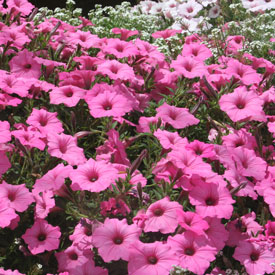
Petunia Bubblegum
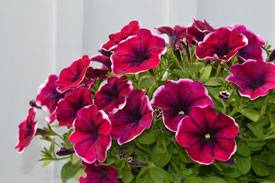
Crazytunia 'Passion Punch'
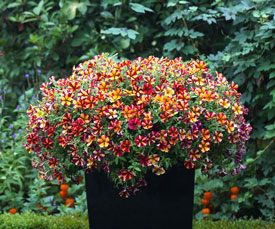
New Crazytunia 'Tiki Torch'
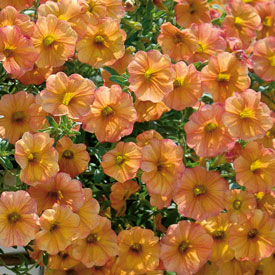
SuperCal Petchoa Terracotta

Calibrachoa Cherry Star
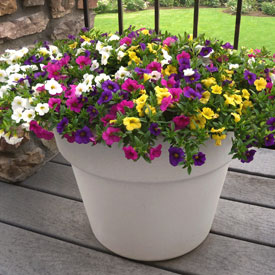
Calibrachoa Calipetites
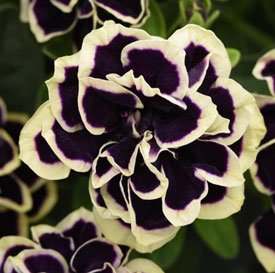
New for 2021 Petunia Midnight Gold


